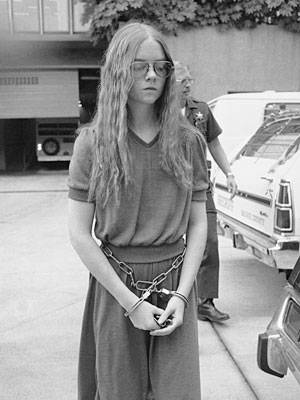“Ugh, it’s Monday” are the words that usually follow the arrival of the most dreaded day of the week. The sighs floating in the air are palpable and nothing seems possible. Mondays always carry with them a negative connotation and contain components such as depression, fatigue, and anguish. But to a San Diego elementary school, and to a troubled sixteen year old, Monday, January 29, 1979 held an even more distressing meaning.

Students at Grover Cleveland Elementary School, located in San Diego, California, began what they believed would be a normal Monday morning like any other, with bells ringing and students racing to their classes. Little did they know, however, that across the street, sixteen-year-old Brenda Ann Spencer was aiming her .22 caliber semiautomatic rifle right at society’s ultimate refuge, the elementary school, and its surroundings. After the first bell rang, Brenda broke the panels on the front door of her home, which was located right across the street from the elementary school. And she began to fire. The school’s principal, Burton Wragg, while rushing outside, was hit on the shoulder and chest with Spencer’s bullets and eventually died. Michael Suchar, the school’s custodian, ran outside with a blanket in order to cover Wragg and keep him from going into shock, but he quickly became the second victim of Spencer’s shooting and lost his life. In between all the chaos, 28 year old Robert Robb, a recent graduate of the police academy, while examining Wragg’s and Suchar’s bodies, was shot under his right shoulder blade.1 He would go on to survive though, along with the eight other children who were wounded in the incident. At least three of those children had abdominal wounds. A nine-year-old student, Cam Miller, was struck in the back with a bullet that exited through his chest without hitting any internal organs. Another, Christy Buell, was shot through her abdomen and in the buttocks, and had to undergo surgery in order to repair her intestine.2
When Gus Stevens, a reporter for the San Diego Evening Tribune, began calling around the area to gain more information about the shooting, he coincidentally placed a call to Spencer’s home where she gave him exactly what he wanted. She described the shooter, a sixteen year old, and the shooter’s address. When Stevens realized that she gave him her own address, he recognized what was going on and requested an interview while another staff member informed the police of the situation. The police, now aware of where the shots were coming from, were able evacuate the children and obstruct Spencer’s line of sight while trying to negotiate with her. After several hours, Brenda Spencer surrendered her weapon and several rounds of ammunition, and was subsequently arrested. While on the phone with Stevens, Spencer had stated that she was just shooting for the “fun of it.” She went on to say that she just didn’t like Mondays and did this “because it’s a way to cheer up the day.”3

Contrary to her initial claim, she later went on to state in her 2001 parole hearing that she had been “sexually abused by [her] father” and was “waiting for the cops to show up so they could shoot [her].”4 This new information has fueled many more theories today about Brenda Spencer’s true motives in committing such a crime. During her pretrial psychological testing, an injury to Spencer’s temporal lobe came to light. Spencer has also stated in a letter from prison that she experiences “grand mal seizures” that she has to counteract with medications.5 Such a brain injury would definitely be a precursor to epilepsy, which is two to four times more common among violent offenders than the public.6 The lack of treatment she received for this disease, to some, proves the neglect that she experienced from her family and in her childhood. Psychologist Jonathan Fast introduces the idea that her brain injury, abuse, and the effects of it pushed her to her final actions. He believes that the shame, ridicule, inferiority, and powerlessness that she felt encouraged her to go as far as she did. In another letter she wrote in prison, she stated that her “father had done everything a person could do to another person. The beatings, the touching, the emotional abuse.” She went on to state that no one, not teachers or counselors, gave her assistance through this, so she simply thought that this was how the world and how life worked. When her father gifted her the .22 caliber rifle, she thought that he was finally telling her to do it: to take her life successfully, unlike her past suicide attempts, and leave the world forever.7
Whether these theories are true or not, Brenda Spencer was tried as an adult and pleaded guilty to two counts of murder and nine counts of assault. She was sentenced to twenty-five years to life in prison, and is still serving her sentence at the California Institute for Women. The shooting has inspired a song by the Boomtown Rats called “I Don’t Like Mondays,” and has also gained other media coverage through a documentary.8 Her action went down in history as the first high profile school shooting and has become a vanguard to many future, unimaginable school situations and violent outbreaks. Whether Spencer was a cold-hearted killer or a truly lost and confused soul that simply wanted an escape, it is undeniable that her horrible actions have had some frightening consequences in our modern world.
- Jonathan Fast, Ceremonial Violence (New York: The Overlook Press, 2008), 25, 70-71. ↵
- Tamara Jones, “Look Back in Sorrow,” Good Housekeeping 227, no.5 (November 1998): 118. ↵
- Jonathan Fast, “Unforgiven and Alone: Brenda Spencer and Secret Shame,” in School Shootings: International Research, Case Studies, And Concepts For Prevention, ed. Nils Böckler (New York: Springer, 2013), 253-255. ↵
- Debra Sevey, “Subsequent Parole Consideration Hearing of Brenda Spencer,” (Capitol Electronic Reporting, 2001), 15-16. ↵
- Jennifer Furio, Letters From Prison: Voices Of Women Murderers (New York: Algora Pub., 2001), 134. ↵
- Jonathan Fast, ” Unforgiven and Alone: Brenda Spencer and Secret Shame,” in School Shootings: International Research, Case Studies, And Concepts For Prevention, ed. Nils Böckler (New York: Springer, 2013), 251. ↵
- Jennifer Furio, Letters From Prison: Voices Of Women Murderers (New York: Algora Pub., 2001), 134-135. ↵
- Encyclopedia of School Crime and Violence, September 2011, s.v. “Brenda Spencer,” by Laura L. Finley. ↵



243 comments
Greyson Addicott
The event that this article describes is anything but uncontroversial. There are some, I am sure, that will attempt to justify Brenda’s actions because of the apparent damage in her brain. Others still will certainly denounce any attempt to justify an action as horrible as shooting at small children. Regardless of my personal opinion, this article does a great job in bringing the reader from the attack to the aftermath. I especially enjoyed the research that went into describing the victims of the gunfire that Brenda unleashed, and although any loss of life is horrible, I am overjoyed that no children were killed!
Roman Olivera
Brenda Spencer is a name that I know for being the first school shooter I had ever heard of being from California. School shootings during the time Brenda committed these acts were unheard of. A case of the Mondays is right! Stating that, she did it for the fun of it, shows that her mental state was not normal. In almost all the cases of these school shooting or even school violence period, there always seems to be a background of some kind of abuse. We will never know what kind of abuses she actually endured as a child, but we can know that she was damaged so severely that she chose to take her anger out on others. This is just the first instance of a trend that has become all too common it our society today.
Sabrina Hsu
School shootings have become one of the biggest issues in our lives today. There have been so many in just this past year it’s unbelievable. This shooting described in the article was only the start of years of shootings to come. It’s really sad what Spencer had to go through because of her dad, but even more sad that she thought doing this would solve all her problems.
Victoria Rodriguez
I have heard of this incident on TV. You did well telling her story and the events leading up to the shooting. It is unfortunate that her life was full of abuse and experiences that can scar a person. What is worse, is that she turned around and inflicted pain onto others. School shootings or any violence being inflicted onto others because of your own hurt and bad feelings is worse and never justifies your actions. The moment an individual goes from victim to aggressor it is hard to humanize them with their past. At what point does somebody realize they are stuck in a cycle and jumps out of it. Is it after they become an aggressor?
Daniela Cardona
This story definitely took a turn. I almost began to feel bad for Brenda after hearing everything she had been through. You could quite obviously tell she had major mental issues. She not only turned herself in, but hoped she would get killed out of it. Still though, that is no excuse for her actions. What she did was awful and at the time unheard of.
Sienna Guerra
This article was disheartening to read since this was one of many school shootings that was the trigger to all the rest of the school shootings just because they wanted to. School shooting are a big deal in this country and to know there has already been over 100 this year alone, may people are dying and it is sick to hear. Spencer, an underage kid with a rifle who was having a bad day was the reason this happened. This all has to do with the right to bear arms and how gun laws are bolstering because of this reason.
Daniela Duran
It is shocking to see how brain injuries, diseases, and even psychological traumas can end up affecting a person’s behavior in such a violent way. Spencer’s actions will never be justifiable, but I believe it is quite sad that her family was a major contributor to her mental condition, given that they didn’t support her with her brain injury, and her dad even abused of her. Certainly, her background had a lot to do with her behavior, and this is why it is so important to offer help to those people suffering from psychological shocks or traumas such as those provoked by sexual assault. This case is a clear example of the harsh long-term impacts of assault and abuse, and it is very sad to see how damaging they can be. I was impressed, however, by the fact that 9 kids were injured, but were able to survive after all! this was miraculous and you can clearly see the hand of God working there! It was amazing how a kid got shot, with the bullet going straight through him, but still did not die. Glory be to Go!
Lyzette Flores
As shocking as it might sound, this was the first time I had personally heard about this shooting. However, this article really helped me understand and grasp the main ideas of it. It is really heartbreaking how nowadays school shootings are coming so common here in the United States. It’s awful knowing that Brenda Spencer had to take such big measures knowing it could have been possibly prevented if others around her knew what was going on and could have helped her out.
Karina Cardona Ruiz
It’s sad that places that should feel safe, like schools, don’t anymore. It’s crazy how this article just talks about one particular shooting, but there has been a numerous amount more since this day and it almost seems as though they are occurring more frequently and consistently. Reading a bit about how Brenda Spencer had been sexually abused by her father makes me feel sympathetic for her but in no way does it justify her actions. Hopefully the day will come when we can get an education and not have to wonder or worry about when the next school shooting will happen or if it will happen to us.
Jabnel Ibarra
“The first high-profile school shooter.” Not really something I’d want to be remembered for. Though I could never find justification for their actions, the first thing I look for in an article about mass shooters is some sort of history of abuse or mental illness. I refuse to believe anyone who isn’t insane or mentally disturbed can choose to end the life of another for no other reason than they just felt like it.